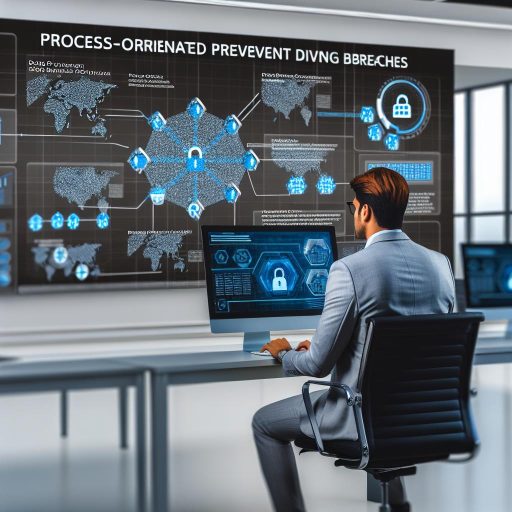Introduction
IT security management is the practice of protecting computer systems and networks from potential threats.
It involves implementing security measures to safeguard sensitive data and ensure business continuity.
Staying ahead of future trends in IT security is crucial to combat evolving cyber threats.
As technology advances, so do the techniques used by hackers to breach security systems.
It is vital for organizations to adapt to new trends in IT security management in order to strengthen their defense mechanisms and mitigate risks effectively.
Embracing innovation and staying proactive are essential in safeguarding sensitive information.
Increasing Sophistication of Cyber Attacks
Discussion on the evolving nature of cyber threats.
Need for advanced security measures to combat sophisticated attacks.
Importance of proactive defense strategies.
The landscape of IT security management is constantly evolving.
This shift is driven by the increasing sophistication of cyber attacks.
Gone are the days when basic security measures could adequately protect organizations from cyber threats.
Today, cyber attackers have become more sophisticated in their methods.
This evolution makes it essential for businesses to enhance their security practices.
One key challenge that IT security professionals face is the evolving nature of cyber threats.
Cyber attackers constantly find new ways to breach security defenses and exploit vulnerabilities.
This dynamic environment requires organizations to stay a step ahead of cybercriminals.
Implementing advanced security measures is vital.
Traditional security solutions are insufficient against modern cyber attacks.
Businesses must invest in next-generation technologies.
Transform Your Career Today
Unlock a personalized career strategy that drives real results. Get tailored advice and a roadmap designed just for you.
Start NowArtificial intelligence and machine learning can help detect sophisticated threats.
Behavioral analytics are also crucial for real-time response to attacks.
By utilizing advanced security measures, organizations can proactively defend against a range of threats.
Proactive defense strategies are essential in the fight against cyber attacks.
Rather than wait for incidents, businesses should adopt a proactive security approach.
This includes continuously monitoring networks for suspicious activities.
Regular security assessments and employee education are also crucial.
Taking a proactive stance strengthens defenses against sophisticated cyber attacks.
This approach involves investing in advanced technologies and fostering a culture of security awareness.
Every employee, from top management to frontline staff, plays a critical role in security.
The increasing sophistication of cyber attacks requires a rethink of security management.
Organizations must recognize the evolving nature of cyber threats.
Implementing advanced security measures and adopting proactive strategies is essential.
By staying vigilant and prepared, businesses can better protect themselves against cybercrime.
Rise of Artificial Intelligence and Machine Learning
As technology continues to evolve, the role of Artificial Intelligence (AI) and Machine Learning (ML) in IT security management is becoming more prominent.
AI and ML are revolutionizing the way organizations approach cybersecurity.
These technologies have the ability to analyze vast amounts of data in real time.
This enables them to detect and respond to threats more efficiently than traditional methods.
Impact of AI and ML on IT security management
The impact of AI and ML on IT security management is significant.
Showcase Your Business Today
Reach thousands of readers actively exploring professional services. Publish your business profile and grow your audience now.
Publish NowThese technologies can identify patterns and anomalies in data that may indicate a security breach.
This allows organizations to respond quickly and effectively to mitigate potential damage.
- Improved threat detection: AI and ML algorithms can analyze network traffic and identify suspicious patterns that traditional tools might miss.
- Enhanced response capabilities: AI can automate responses to security incidents, minimizing the time it takes to contain a breach.
- Increased efficiency: By automating routine tasks, AI and ML can free up IT security personnel to focus on more strategic initiatives.
Potential benefits of AI in threat detection and response
There are numerous benefits to leveraging AI in threat detection and response, including:
- Faster detection: AI can detect threats in real time, allowing organizations to respond quickly.
- Increased accuracy: AI algorithms can analyze data more comprehensively and accurately than humans, reducing false positives.
- Continuous monitoring: AI can monitor network activity 24/7, ensuring that threats are detected promptly.
Challenges in implementing AI-driven security solutions
While the potential benefits of AI in threat detection and response are significant, there are challenges that organizations must overcome when implementing AI-driven security solutions:
- Data quality: AI algorithms rely on high-quality data to make accurate decisions. Poor data quality can lead to inaccurate results.
- Complexity: AI and ML technologies can be complex to implement and require specialized knowledge to configure and maintain.
- Security concerns: AI itself can be vulnerable to attacks, and organizations must ensure that their AI systems are secure from potential threats.
The rise of AI and ML in IT security management presents a significant opportunity for organizations.
By leveraging the power of AI and ML, organizations can improve threat detection, response times, and overall security posture.
You Might Also Like: The Role of a Systems Analyst in IT Project Management
Shift Towards Zero Trust Security Model
In the rapidly evolving landscape of IT security management, organizations are increasingly shifting towards adopting a Zero Trust security model to enhance their cybersecurity posture.
Explanation of zero trust security approach
The Zero Trust security approach is based on the principle of assuming that threats exist both inside and outside the network.
This means that no user or device should be trusted by default, regardless of their location.
Under the Zero Trust model, access to resources is granted on a least-privileged basis.
This means that users are only given access to the specific resources they need to perform their job functions.
This minimizes the risk of unauthorized access and lateral movement of threats within the network.
Advantages of zero trust model in preventing data breaches
- Enhanced security: By not trusting any user or device by default, the Zero Trust model minimizes the risk of data breaches and unauthorized access.
- Granular access controls: This approach allows organizations to enforce granular access controls, ensuring that users only have access to the resources they need to perform their tasks.
- Improved visibility: Zero Trust model provides organizations with better visibility into their network, allowing them to monitor user activity and detect anomalies in real-time.
- Resilience against insider threats: By assuming that threats can originate from within the network, the Zero Trust model helps organizations protect against insider threats.
- Compliance: Implementing a Zero Trust approach can help organizations meet regulatory compliance requirements by implementing robust security measures.
Implementation strategies for adopting zero trust principles
- Identify critical assets: Organizations should start by identifying their critical assets and categorizing them based on their importance and sensitivity.
- Implement strong authentication: Enforce multi-factor authentication to verify the identity of users and devices accessing the network.
- Segment network: Segmenting the network into smaller, isolated zones can help contain and mitigate the impact of security incidents.
- Continuous monitoring: Implement continuous monitoring and analysis of network traffic to detect and respond to threats in real-time.
- Employee training: Educate employees about the importance of cybersecurity and the role they play in maintaining a secure network.
You Might Also Like: Effective Communication Tips for Systems Administrators
Growing Importance of Cloud Security
Discussion on the expanding use of cloud-based services
The use of cloud-based services has grown exponentially in recent years.
Organizations are leveraging the scalability and flexibility that the cloud offers.
This trend is expected to continue, as more businesses move their operations to the cloud.
They do this to increase efficiency and reduce costs.
However, with this increased reliance on cloud services comes the need for enhanced security measures.
Organizations must protect sensitive data and systems from cyber threats.
Challenges in securing data in the cloud
One of the main challenges in securing data in the cloud is the shared responsibility model.
While cloud service providers are responsible for securing the infrastructure, organizations must protect their data.
This can be a complex task that requires ensuring data is encrypted.
Organizations must also implement access controls and enforce security policies.
Another challenge is the lack of visibility and control.
When data is stored in the cloud, organizations may have limited visibility into how it is accessed and used.
This limitation can make it difficult to detect and respond to security incidents in a timely manner.
Moreover, monitoring and enforcing security policies across multiple cloud environments can be challenging.
Data residency and compliance requirements also pose challenges for organizations using cloud services.
Depending on the industry and location, organizations may need to adhere to strict data protection regulations.
This can complicate the process of securing data in the cloud.
Organizations must ensure data is stored in compliant environments.
Access controls must also align with regulatory requirements.
Best practices for ensuring cloud security
- Implement strong authentication mechanisms: Organizations should use multi-factor authentication to verify the identity of users accessing cloud services.
- Encrypt data at rest and in transit: Data should be encrypted both when it is stored in the cloud and when it is transmitted between systems.
- Regularly monitor and audit cloud environments: Organizations should continuously monitor their cloud environments for any unusual activity or unauthorized access.
- Implement access controls and least privilege: Limit access to sensitive data and systems to authorized users only, following the principle of least privilege.
- Train employees on security best practices: Educate employees on the importance of security and provide training on how to securely use cloud services.
- Keep software and systems up to date: Organizations should regularly update their software and systems to patch vulnerabilities and defend against emerging threats.
- Work with trusted cloud service providers: Choose reputable cloud service providers with strong security practices and compliance certifications.
By following these best practices and staying informed about the latest developments in cloud security, organizations can minimize the risks associated with using cloud services.
Gain More Insights: Career Path for Back End Developers

Endpoint Security in IT Security Management
Endpoint security plays a crucial role in safeguarding an organization’s network and data from potential cyber threats.
In simple terms, an endpoint is any device that connects to a network, such as laptops, smartphones, tablets, and servers.
Explanation of Endpoint Security
- Endpoint security involves protecting these devices from unauthorized access and malicious activities.
- It is designed to detect, prevent, and respond to cyber threats that target endpoints.
- Endpoint security solutions aim to secure devices both within and outside the corporate network.
Strategies for Securing Endpoints in a Remote Work Environment
- Implementing strong password policies and multi-factor authentication for remote access.
- Enforcing encryption on endpoint devices to protect data in transit and at rest.
- Regularly updating software and applications to patch vulnerabilities and enhance security.
- Deploying endpoint security solutions such as antivirus software, firewalls, and intrusion detection/prevention systems.
- Conducting security awareness training for employees to educate them about best practices in endpoint security.
Importance of Endpoint Detection and Response (EDR) Solutions
- EDR solutions provide real-time monitoring and threat detection capabilities to identify and respond to security incidents.
- They offer visibility into endpoint activities and behavior to detect advanced threats that traditional security measures may miss.
- EDR solutions enable automated response actions to contain and mitigate security incidents before they escalate.
Endpoint security is a critical component of IT security management, especially in today’s digital landscape where remote work is becoming more prevalent.
By implementing robust endpoint security measures and leveraging EDR solutions, organizations can strengthen their defenses against evolving cyber threats and safeguard their sensitive information.
Showcase Your Business Today
Reach thousands of readers actively exploring professional services. Publish your business profile and grow your audience now.
Publish NowDelve into the Subject: ERP Consultant Collaboration with IT Teams
Compliance and Regulatory Changes
Keeping up with compliance and regulatory changes is crucial in the field of IT security management.
As technology advances and new threats emerge, regulations evolve to ensure data protection and cybersecurity.
Understanding current regulations and their impact on IT security is essential.
Regulations such as GDPR, HIPAA, PCI DSS, and others have a significant influence on how organizations handle data and protect sensitive information.
Non-compliance can result in severe consequences, including hefty fines and reputational damage.
IT security professionals must stay informed about these regulations to avoid legal issues.
Importance of Compliance with Industry Standards
Compliance with industry standards is essential for organizations to demonstrate their commitment to security and privacy.
Adhering to regulations not only protects the organization but also instills trust among customers and stakeholders.
It shows that the company takes data protection seriously and is dedicated to maintaining a secure environment.
Industry standards provide guidelines and best practices for managing IT security effectively.
By following these standards, organizations can reduce the risk of security breaches and data leaks.
Furthermore, compliance with industry standards helps companies align with global security practices and ensures consistency in security measures across different regions.
Strategies for Maintaining Compliance
Adapting to new trends in IT security while maintaining compliance can be challenging.
However, with the right strategies in place, organizations can effectively manage their security posture and stay compliant with regulations.
Here are some strategies to consider:
- Regular risk assessments: Conducting regular risk assessments allows organizations to identify potential security gaps and address them proactively.
- Employee training: Educating employees on security best practices and compliance requirements is crucial for maintaining a secure environment.
- Monitoring and auditing: Implementing robust monitoring and auditing processes helps organizations track compliance and identify non-compliance issues.
- Incident response planning: Developing a comprehensive incident response plan enables organizations to respond effectively to security incidents and mitigate risks.
- Engaging with regulatory bodies: Building a strong relationship with regulatory bodies can help organizations stay updated on new regulations and compliance requirements.
By implementing these strategies and staying proactive in their approach to compliance, organizations can effectively navigate regulatory changes and maintain a strong security posture.
Compliance with industry standards not only protects the organization from legal repercussions but also helps build a culture of security and trust within the organization.
Staying Informed on IT Security Trends
Staying informed about future trends in IT security is crucial for staying ahead of cyber threats.
IT professionals must prioritize security updates and training to protect sensitive data.
The continuous evolution of IT security management requires constant vigilance and adaptation to address emerging risks proactively.
As technology advances, so do the tactics of cybercriminals.
By staying informed and investing in up-to-date security measures, organizations can safeguard against potential breaches and data theft.
It is imperative that IT professionals remain vigilant and proactive in their approach to managing IT security.
They must ensure the protection of their systems and data.
Therefore, it is essential to consistently educate oneself on the latest trends and best practices in IT security management.
By doing so, IT professionals can effectively mitigate risks, safeguard digital assets, and bolster cybersecurity defenses.
The landscape of IT security is constantly evolving.
It is the responsibility of every individual in the field to adapt and stay informed to protect against emerging threats.
Additional Resources
National Emergency Response Information System (NERIS)
The IT Industry: How Today’s Technology Can Shape Our Future …
[E-Books for Sale]
The Big Book of 500 High-Paying Jobs in America: Unlock Your Earning Potential
$19.99 • 500 High-Paying Jobs • 330 pages
Explore 500 high-paying jobs in America and learn how to boost your career, earn more, and achieve success!
See All 500 High-Paying Jobs of this E-Book
1001 Professions Without a Degree: High-Paying American Jobs You Can Start Now
$19.99 • 1001 Professions Without a Degree • 174 pages
Discover 1001 high-paying jobs without a degree! Unlock career tips, skills, and success strategies for just $19.99!




